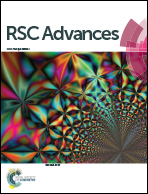Effect of high molecular weight hyaluronic acid on chondrocytes cultured in collagen/hyaluronic acid porous scaffolds†
Abstract
Engineering cartilage tissue by culturing chondrocytes in porous scaffolds is one promising method to repair or restore the functions of diseased cartilage. Hyaluronic aid (HA) was used in porous scaffolds or hydrogels to promote the proliferation of chondrocytes and synthesis of cartilage extracellular matrix (ECM). However, whether HA in scaffolds has a beneficial effect on chondrocytes remains uncertain, possibly due to the uncontrolled pore structure and inhomogeneous HA in scaffolds. In this study, homogeneous collagen/HA scaffolds with well-controlled and interconnected pore structure were prepared by suppression of polyion complex formation between collagen and HA and using ice particulates as porogen. The pore structure and mechanical property of collagen/HA scaffolds and collagen scaffolds could be well controlled. High molecular weight HA in collagen/HA scaffolds inhibited the cellular proliferation, synthesis of sulfated glycosaminoglycan and cartilage ECM, compared with the results of collagen scaffolds. This study should provide additional information on the effects of HA in porous scaffolds on the chondrocyte behaviour in 3D culture.


 Please wait while we load your content...
Please wait while we load your content...